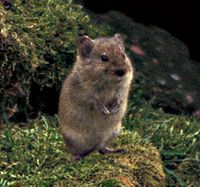Singing vole
| Singing Vole | |
|---|---|
 |
|
| Scientific classification | |
| Kingdom: | Animalia |
| Phylum: | Chordata |
| Class: | Mammalia |
| Order: | Rodentia |
| Family: | Cricetidae |
| Genus: | Microtus |
| Species: | M. miurus |
| Binomial name | |
|
Microtus miurus Osgood, 1901 |
|
| Subspecies | |
|
See text |
|
See text
The singing vole (Microtus miurus), is a medium-sized vole found in northwestern North America, including Alaska and northwestern Canada.
Singing voles have short ears, often concealed by their long fur, and a short tail. The fur is soft and dense, especially in winter. They vary in color from pale tawny to pale grey, with buff-colored patches running from the undersides of the ears along the flanks to the rump, and buff or ochre underparts. The fur is lightly ticked with black guard hairs, but these are so sparse that have little effect on the visible coloration of the animal. The fur is greyer in color during the winter. The paws have sharp, narrow claws, which are largely hidden by fur.
Adult singing voles range from 9 to 16 centimetres (3.5 to 6.3 in) in length, not counting the short, 1.5 to 4 centimetres (0.59 to 1.57 in), tail. They can weigh anything from 11 to 60 grams (0.39 to 2.12 oz), depending on their exact age and recent diet. There is no significant difference in size or coloration between the two sexes. Male singing voles possess modified sebaceous glands on their flanks, which are used in scent marking; these glands have also been noted in some lactating females. The penis is relatively long and narrow, with a complex baculum.
Singing voles can be distinguished from other neighboring vole species by their shorter tails and the color of their underparts (other local voles have grey underparts).
Singing voles are native to Alaska and north-western Canada. They are found from the western coasts, across southern and northern Alaska, but avoid the Alaska Peninsula, the central regions, and much of the northern coast. In the east, they reach as far as the Mackenzie Mountains, being found throughout the Yukon, aside from the northern coasts, and in border regions of the neighboring provinces.
Four subspecies are currently recognised:
Singing voles are found in tundra regions above the tree line. They avoid the most extreme environments within these regions, preferring open, well-drained slopes and rock flats with abundant shrubs and sedges. They feed on arctic plants such as lupines, knotweed, sedges, horsetails, and willows. Their main predators include wolverines, Arctic foxes, stoats, skuas, hawks, and owls.
...
Wikipedia

